Engagement of Language and Domain General Networks during Word Monitoring in a Native and Unknown Language
Abstract
:1. Introduction
2. Materials and Methods
2.1. Participants
2.2. Inclusion or Exclusion Criteria
2.3. Word Monitoring Task
2.3.1. Texts, Audios and Sound Systems Used in the Paradigm
2.3.2. Positioning and Orientation in the Scanner
2.3.3. Pre- and Post-fMRI
2.3.4. Image Acquisition
2.3.5. Image Processing
2.4. Behavioral Data
3. Results
3.1. Demographic Results
3.2. Behavioral Assessment in the Auditory Attention Task
3.2.1. Accuracies and Errors
3.2.2. Hit Reaction Time (HRT)
3.3. fMRI Results
4. Discussion
5. Conclusions
Author Contributions
Funding
Institutional Review Board Statement
Informed Consent Statement
Data Availability Statement
Acknowledgments
Conflicts of Interest
Appendix A. The 2D fMRI Maps of All Brain Slices for Both Active Conditions (NL, UL) and for Both Contrasts (NL > UL and UL > NL)
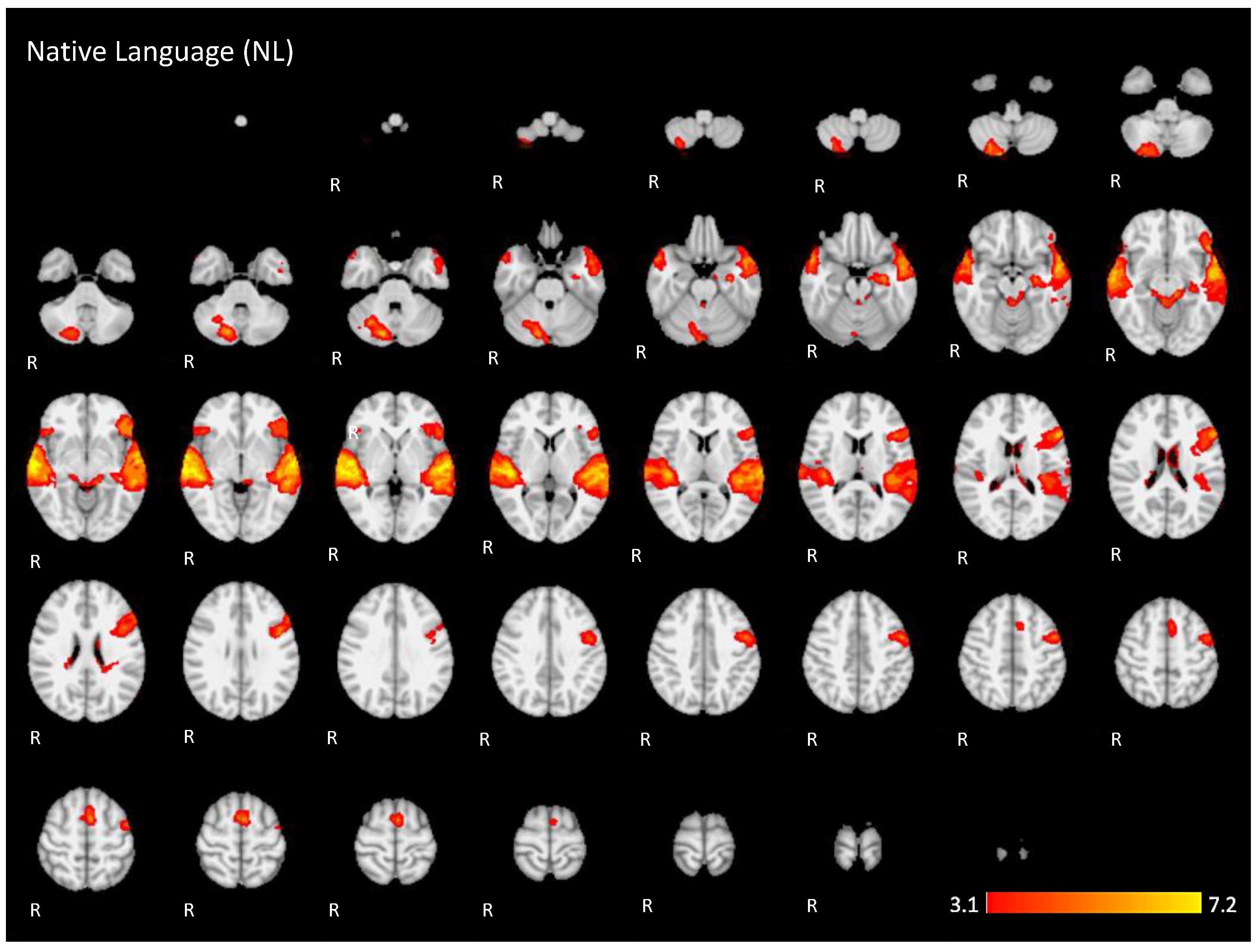

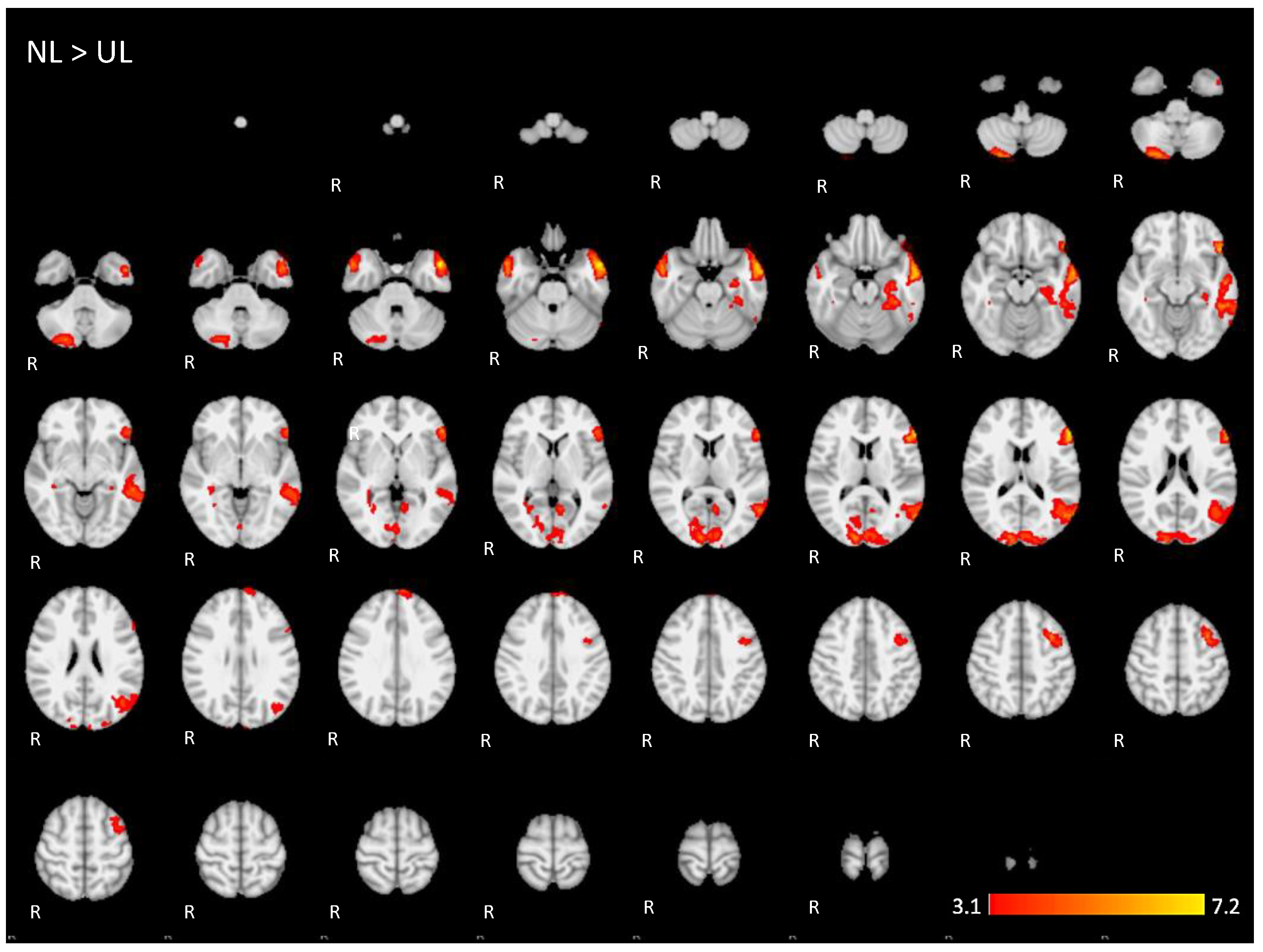
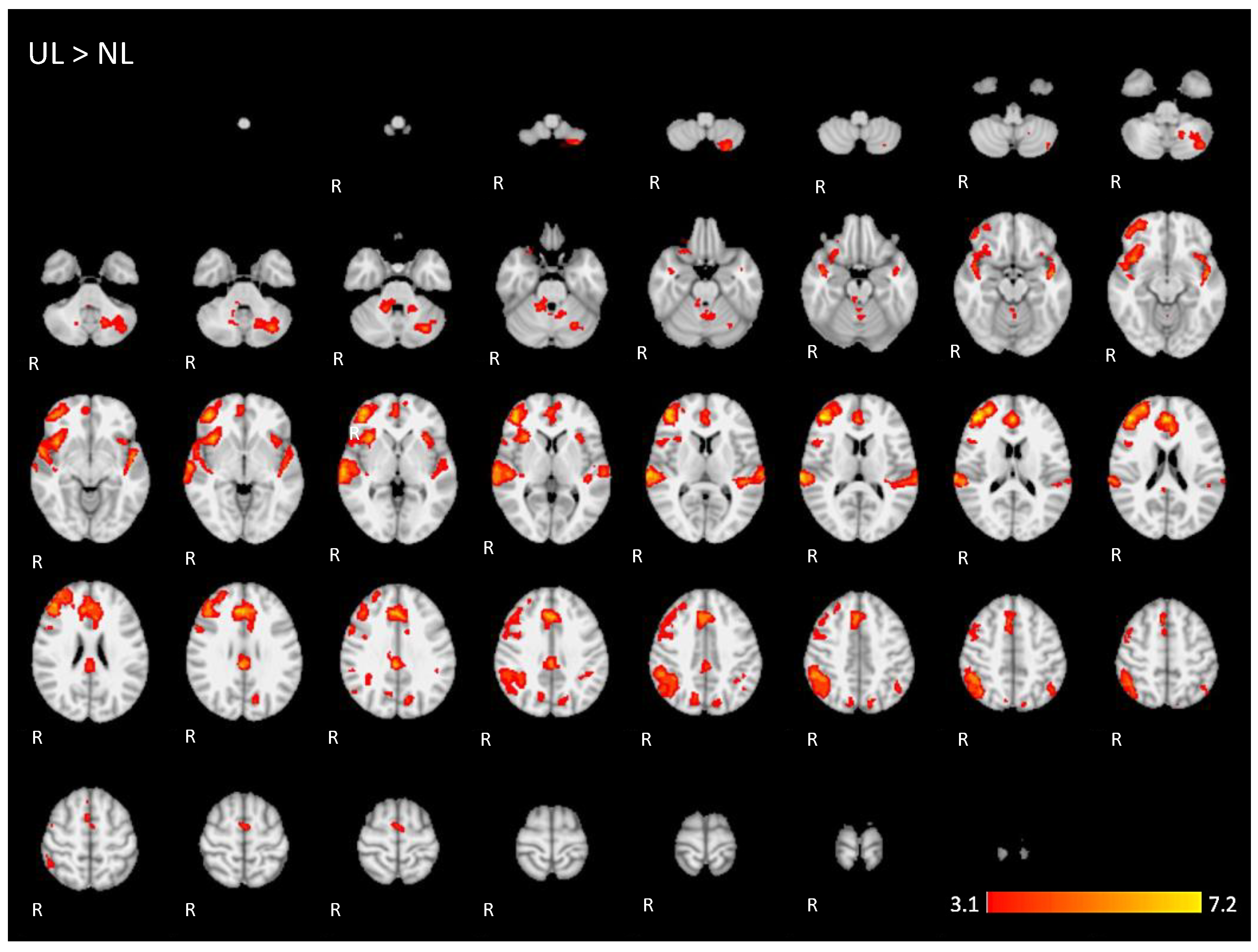
References
- Hickok, G.; Poeppel, D. The cortical organization of speech processing. Nat. Rev. Neurosci. 2007, 8, 393–402. [Google Scholar] [CrossRef]
- Saur, D.; Kreher, B.W.; Schnell, S.; Kummerer, D.; Kellmeyer, P.; Vry, M.S.; Umarova, R.; Musso, M.; Glauche, V.; Abel, S.; et al. Ventral and dorsal pathways for language. Proc. Natl. Acad. Sci. USA 2008, 105, 18035–18040. [Google Scholar] [CrossRef] [Green Version]
- Blank, I.A.; Fedorenko, E. Domain-general brain regions do not track linguistic input as closely as language-selective regions. J. Neurosci. Off. J. Soc. Neurosci. 2017, 37, 9999–10011. [Google Scholar] [CrossRef] [Green Version]
- Majerus, S. Language repetition and short-term memory: An integrative framework. Front. Hum. Neurosci. 2013, 7. [Google Scholar] [CrossRef] [Green Version]
- Vigneau, M.; Beaucousin, V.; Herve, P.Y.; Jobard, G.; Petit, L.; Crivello, F.; Mellet, E.; Zago, L.; Mazoyer, B.; Tzourio-Mazoyer, N. What is right-hemisphere contribution to phonological, lexico-semantic, and sentence processing? Insights from a meta-analysis. NeuroImage 2011, 54, 577–593. [Google Scholar] [CrossRef]
- Olulade, O.A.; Seydell-Greenwald, A.; Chambers, C.E.; Turkeltaub, P.E.; Dromerick, A.W.; Berl, M.M.; Gaillard, W.D.; Newport, E.L. The neural basis of language development: Changes in lateralization over age. Proc. Natl. Acad. Sci. USA 2020, 117, 23477–23483. [Google Scholar] [CrossRef] [PubMed]
- Gurunandan, K.; Arnaez-Telleria, J.; Carreiras, M.; Paz-Alonso, P.M. Converging evidence for differential specialization and plasticity of language systems. J. Neurosci. Off. J. Soc. Neurosci. 2020, 40, 9715–9724. [Google Scholar] [CrossRef]
- López-Barroso, D.; Thiebaut de Schotten, M.; Morais, J.; Kolinsky, R.; Braga, L.W.; Guerreiro-Tauil, A.; Dehaene, S.; Cohen, L. Impact of literacy on the functional connectivity of vision and language related networks. NeuroImage 2020, 213, 116722. [Google Scholar] [CrossRef] [PubMed]
- Kiran, S.; Thompson, C.K. Neuroplasticity of language networks in aphasia: Advances, updates, and future challenges. Front. Neurol. 2019, 10, 295. [Google Scholar] [CrossRef] [Green Version]
- Cabeza, R.; Anderson, N.D.; Locantore, J.K.; McIntosh, A.R. Aging gracefully: Compensatory brain activity in high-performing older adults. NeuroImage 2002, 17, 1394–1402. [Google Scholar] [CrossRef]
- Campbell, K.L.; Grady, C.L.; Ng, C.; Hasher, L. Age differences in the frontoparietal cognitive control network: Implications for distractibility. Neuropsychologia 2012, 50, 2212–2223. [Google Scholar] [CrossRef] [PubMed] [Green Version]
- Murphy, E.; Benitez-Burraco, A. Toward the language oscillogenome. Front. Psychol. 2018, 9, 1999. [Google Scholar] [CrossRef] [Green Version]
- Murphy, E. The Oscillatory Nature of Language; Cambridge University Press: Cambridge, UK, 2020. [Google Scholar] [CrossRef]
- Yang, C.; Crain, S.; Berwick, R.C.; Chomsky, N.; Bolhuis, J.J. The growth of language: Universal Grammar, experience, and principles of computation. Neurosci. Biobehav. Rev. 2017, 81, 103–119. [Google Scholar] [CrossRef] [PubMed]
- Price, C.J. The anatomy of language: A review of 100 fMRI studies published in 2009. Ann. N. Y. Acad. Sci. 2010, 1191, 62–88. [Google Scholar] [CrossRef]
- Fox, M.D.; Snyder, A.Z.; Vincent, J.L.; Corbetta, M.; Van Essen, D.C.; Raichle, M.E. The human brain is intrinsically organized into dynamic, anticorrelated functional networks. Proc. Natl. Acad. Sci. USA 2005, 102, 9673–9678. [Google Scholar] [CrossRef] [Green Version]
- Guerra, R.O.; Alvarado, B.E.; Zunzunegui, M.V. Life course, gender and ethnic inequalities in functional disability in a Brazilian urban elderly population. Aging Clin. Exp. Res. 2008, 20, 53–61. [Google Scholar] [CrossRef]
- Ardila, A.; Bertolucci, P.H.; Braga, L.W.; Castro-Caldas, A.; Judd, T.; Kosmidis, M.H.; Matute, E.; Nitrini, R.; Ostrosky-Solis, F.; Rosselli, M. Illiteracy: The neuropsychology of cognition without reading. Arch. Clin. Neuropsychol. 2010, 25, 689–712. [Google Scholar] [CrossRef] [Green Version]
- Huettig, F.; Mishra, R.K. How literacy acquisition affects the illiterate mind—A critical examination of theories and evidence. Lang. Linguist. Compass 2014, 8, 401–427. [Google Scholar] [CrossRef] [Green Version]
- Kosmidis, M.H.; Tsapkini, K.; Folia, V.; Vlahou, C.H.; Kiosseoglou, G. Semantic and phonological processing in illiteracy. J. Int. Neuropsychol. Soc. 2004, 10, 818–827. [Google Scholar] [CrossRef] [PubMed]
- Gonzalez-Burgos, L.; Pereira, J.B.; Mohanty, R.; Barroso, J.; Westman, E.; Ferreira, D. Cortical networks underpinning compensation of verbal fluency in normal aging. Cereb. Cortex 2021, 31, 3832–3845. [Google Scholar] [CrossRef] [PubMed]
- Liu, T.T.; Frank, L.R.; Wong, E.C.; Buxton, R.B. Detection power, estimation efficiency, and predictability in event-related fMRI. NeuroImage 2001, 13, 759–773. [Google Scholar] [CrossRef] [Green Version]
- Kilborn, K.; Moss, H. Word monitoring. Lang. Cogn. Process. 1996, 11, 689–694. [Google Scholar]
- Rondinoni, C.; Amaro, E., Jr.; Cendes, F.; dos Santos, A.C.; Salmon, C.E. Effect of scanner acoustic background noise on strict resting-state fMRI. Braz. J. Med. Biol. Res. 2013, 46, 359–367. [Google Scholar] [CrossRef] [Green Version]
- Smith, S.M. Fast robust automated brain extraction. Hum. Brain Mapp. 2002, 17, 143–155. [Google Scholar] [CrossRef]
- Woolrich, M.W.; Ripley, B.D.; Brady, M.; Smith, S.M. Temporal autocorrelation in univariate linear modeling of FMRI data. NeuroImage 2001, 14, 1370–1386. [Google Scholar] [CrossRef] [PubMed] [Green Version]
- Jezzard, P.; Matthews, P.M.; Smith, S.M. Functional MRI: An Introduction to Methods; Oxford University Press: Oxford, NY, USA, 2001; 390p. [Google Scholar]
- Macmillan, N.A.; Kaplan, H.L. Detection theory analysis of group data: Estimating sensitivity from average hit and false-alarm rates. Psychol. Bull. 1985, 98, 185–199. [Google Scholar] [CrossRef] [PubMed]
- Blank, M.A.; Pisoni, D.B.; McClaskey, C.L. Effects of target monitoring on understanding fluent speech. Percept. Psychophys. 1981, 29, 383–388. [Google Scholar] [CrossRef] [PubMed] [Green Version]
- Patterson, K.; Nestor, P.J.; Rogers, T.T. Where do you know what you know? The representation of semantic knowledge in the human brain. Nat. Rev. Neurosci. 2007, 8, 976–987. [Google Scholar] [CrossRef] [PubMed]
- Ralph, M.A.; Jefferies, E.; Patterson, K.; Rogers, T.T. The neural and computational bases of semantic cognition. Nat. Rev. Neurosci. 2017, 18, 42–55. [Google Scholar] [CrossRef]
- Hwang, K.; Hallquist, M.N.; Luna, B. The development of hub architecture in the human functional brain network. Cereb. Cortex 2013, 23, 2380–2393. [Google Scholar] [CrossRef]
- Mazoyer, B.M.; Tzourio, N.; Frak, V.; Syrota, A.; Murayama, N.; Levrier, O.; Salamon, G.; Dehaene, S.; Cohen, L.; Mehler, J. The cortical representation of speech. J. Cogn. Neurosci. 1993, 5, 467–479. [Google Scholar] [CrossRef] [Green Version]
- Binder, J.R.; Desai, R.H.; Graves, W.W.; Conant, L.L. Where is the semantic system? A critical review and meta-analysis of 120 functional neuroimaging studies. Cereb. Cortex 2009, 19, 2767–2796. [Google Scholar] [CrossRef]
- Oh, A.; Duerden, E.G.; Pang, E.W. The role of the insula in speech and language processing. Brain Lang. 2014, 135, 96–103. [Google Scholar] [CrossRef] [PubMed] [Green Version]
- Marien, P.; Borgatti, R. Language and the cerebellum. Handb. Clin. Neurol. 2018, 154, 181–202. [Google Scholar] [CrossRef]
- Davis, M.H.; Johnsrude, I.S. Hierarchical processing in spoken language comprehension. J. Neurosci. 2003, 23, 3423–3431. [Google Scholar] [CrossRef] [PubMed] [Green Version]
- Wild, C.J.; Yusuf, A.; Wilson, D.E.; Peelle, J.E.; Davis, M.H.; Johnsrude, I.S. Effortful listening: The processing of degraded speech depends critically on attention. J. Neurosci. 2012, 32, 14010–14021. [Google Scholar] [CrossRef] [PubMed] [Green Version]
- Majerus, S.; Poncelet, M.; Van der Linden, M.; Albouy, G.; Salmon, E.; Sterpenich, V.; Vandewalle, G.; Collette, F.; Maquet, P. The left intraparietal sulcus and verbal short-term memory: Focus of attention or serial order? NeuroImage 2006, 32, 880–891. [Google Scholar] [CrossRef]
- Dormal, V.; Dormal, G.; Joassin, F.; Pesenti, M. A common right fronto-parietal network for numerosity and duration processing: An fMRI study. Hum. Brain Mapp. 2012, 33, 1490–1501. [Google Scholar] [CrossRef]
- Kaufmann, L.; Vogel, S.; Starke, M.; Kremser, C.; Schocke, M. Numerical and non-numerical ordinality processing in children with and without developmental dyscalculia: Evidence from fMRI. Cogn. Dev. 2009, 24, 486–494. [Google Scholar] [CrossRef]
- Hertrich, I.; Dietrich, S.; Ackermann, H. The margins of the language network in the brain. Front. Commun. 2020, 5, 93. [Google Scholar] [CrossRef]
- Diachek, E.; Blank, I.; Siegelman, M.; Affourtit, J.; Fedorenko, E. The domain-general multiple demand (MD) network does not support core aspects of language comprehension: A large-scale fMRI investigation. J. Neurosci. 2020, 40, 4536–4550. [Google Scholar] [CrossRef] [PubMed]
- Wehbe, L.; Blank, I.A.; Shain, C.; Futrell, R.; Levy, R.; von der Malsburg, T.; Smith, N.; Gibson, E.; Fedorenko, E. Incremental language comprehension difficulty predicts activity in the language network but not the multiple demand network. Cereb. Cortex 2021, 31, 4006–4023. [Google Scholar] [CrossRef]
- Meltzer, J.A.; Kielar, A.; Panamsky, L.; Links, K.A.; Deschamps, T.; Leigh, R.C. Electrophysiological signatures of phonological and semantic maintenance in sentence repetition. NeuroImage 2017, 156, 302–314. [Google Scholar] [CrossRef]
- Majerus, S.; D’Argembeau, A.; Martinez Perez, T.; Belayachi, S.; Van der Linden, M.; Collette, F.; Salmon, E.; Seurinck, R.; Fias, W.; Maquet, P. The commonality of neural networks for verbal and visual short-term memory. J. Cogn. Neurosci. 2010, 22, 2570–2593. [Google Scholar] [CrossRef] [Green Version]
- Basho, S.; Palmer, E.D.; Rubio, M.A.; Wulfeck, B.; Muller, R.A. Effects of generation mode in fMRI adaptations of semantic fluency: Paced production and overt speech. Neuropsychologia 2007, 45, 1697–1706. [Google Scholar] [CrossRef] [Green Version]
- Meltzer, J.A.; Braun, A.R. An EEG-MEG dissociation between online syntactic comprehension and post hoc reanalysis. Front. Hum. Neurosci. 2011, 5, 10. [Google Scholar] [CrossRef] [Green Version]
- Vartanian, O.; Goel, V. Task constraints modulate activation in right ventral lateral prefrontal cortex. NeuroImage 2005, 27, 927–933. [Google Scholar] [CrossRef]
- Buckner, R.L.; Raichle, M.E.; Petersen, S.E. Dissociation of human prefrontal cortical areas across different speech production tasks and gender groups. J. Neurophysiol. 1995, 74, 2163–2173. [Google Scholar] [CrossRef] [PubMed] [Green Version]
- Ries, S.K.; Dronkers, N.F.; Knight, R.T. Choosing words: Left hemisphere, right hemisphere, or both? Perspective on the lateralization of word retrieval. Ann. N. Y. Acad. Sci. 2016, 1369, 111–131. [Google Scholar] [CrossRef] [PubMed]
- Meltzer, J.A.; Wagage, S.; Ryder, J.; Solomon, B.; Braun, A.R. Adaptive significance of right hemisphere activation in aphasic language comprehension. Neuropsychologia 2013, 51, 1248–1259. [Google Scholar] [CrossRef] [Green Version]
- Turkeltaub, P.E. Brain stimulation and the role of the right hemisphere in aphasia recovery. Curr. Neurol. Neurosci. Rep. 2015, 15, 72. [Google Scholar] [CrossRef] [PubMed]
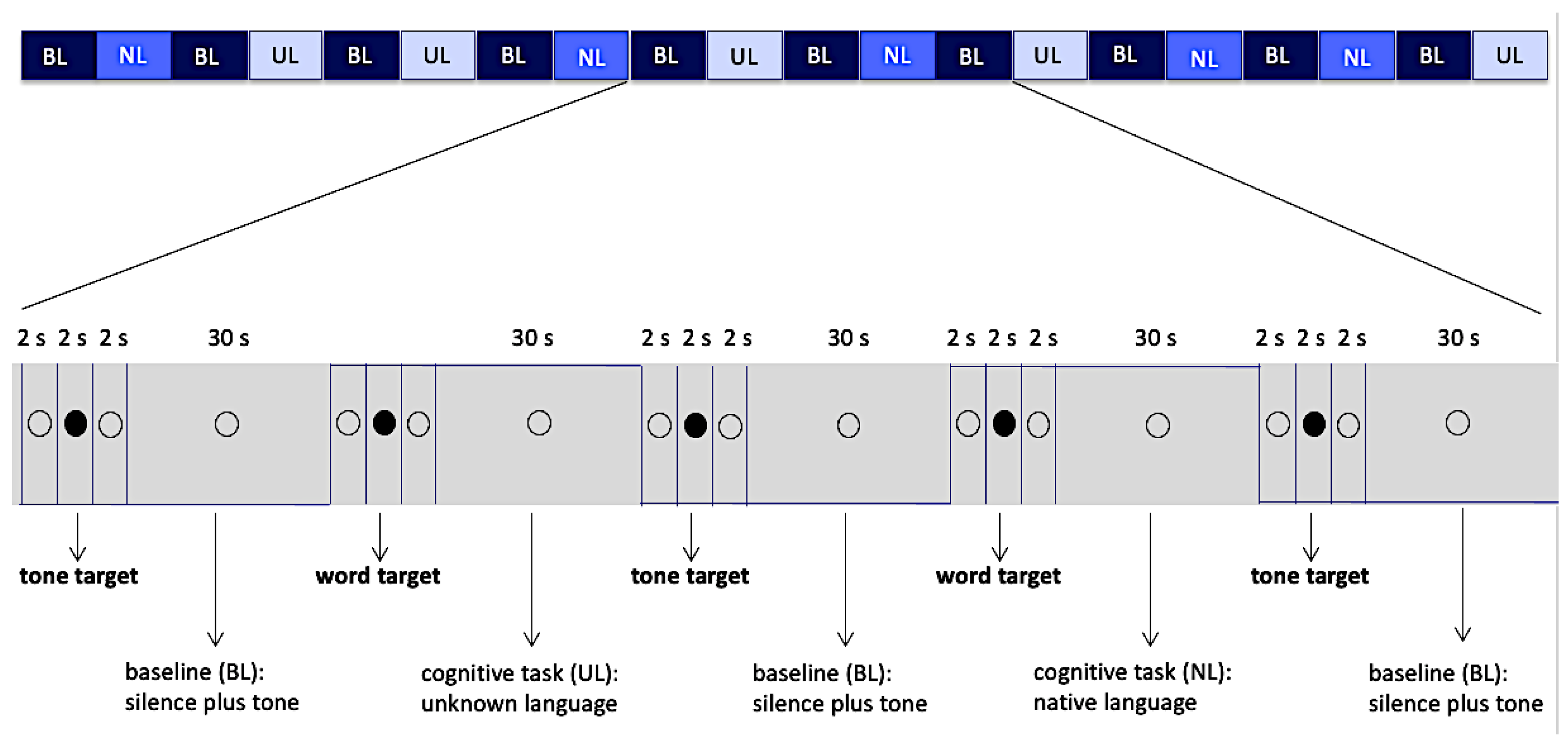
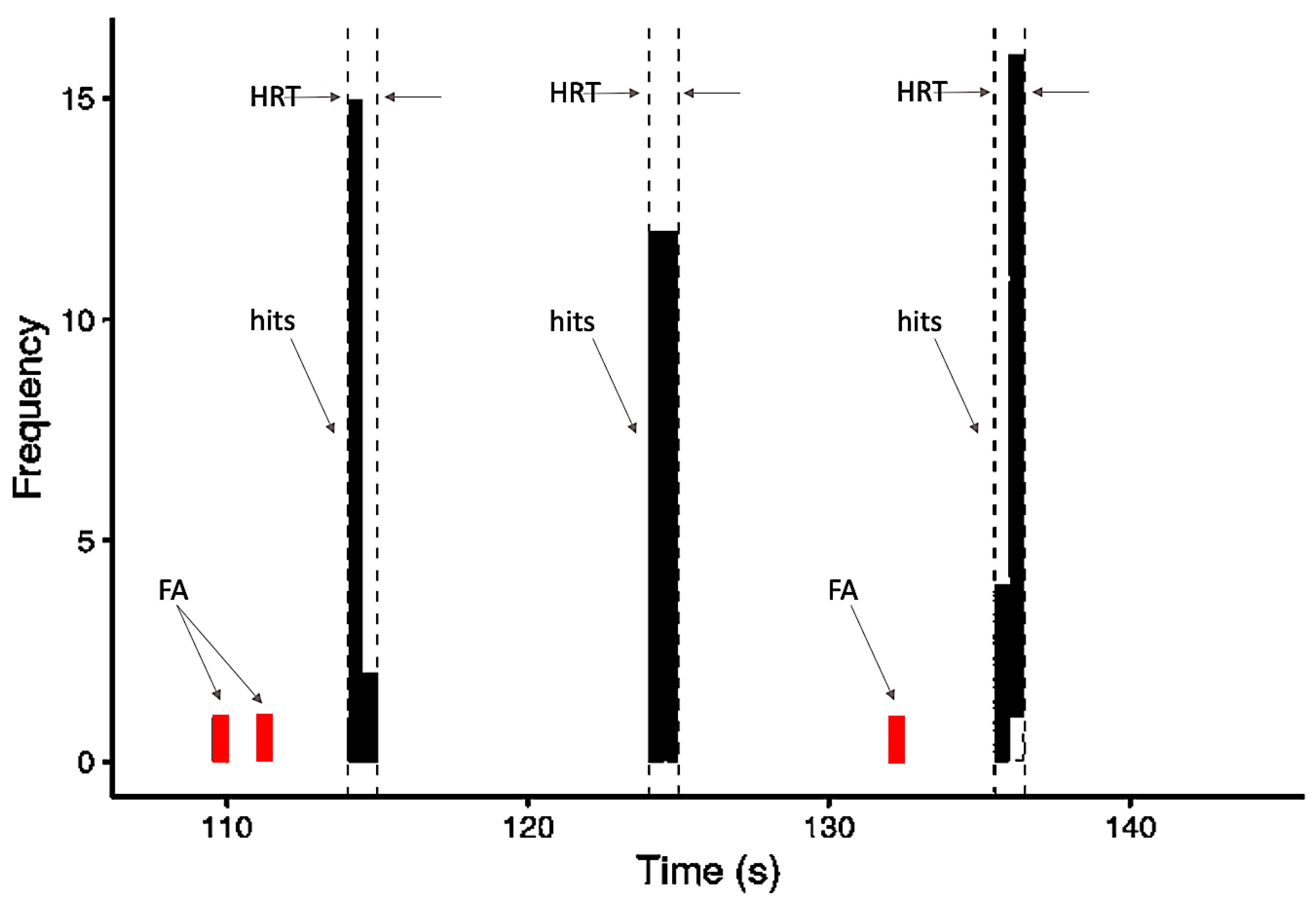

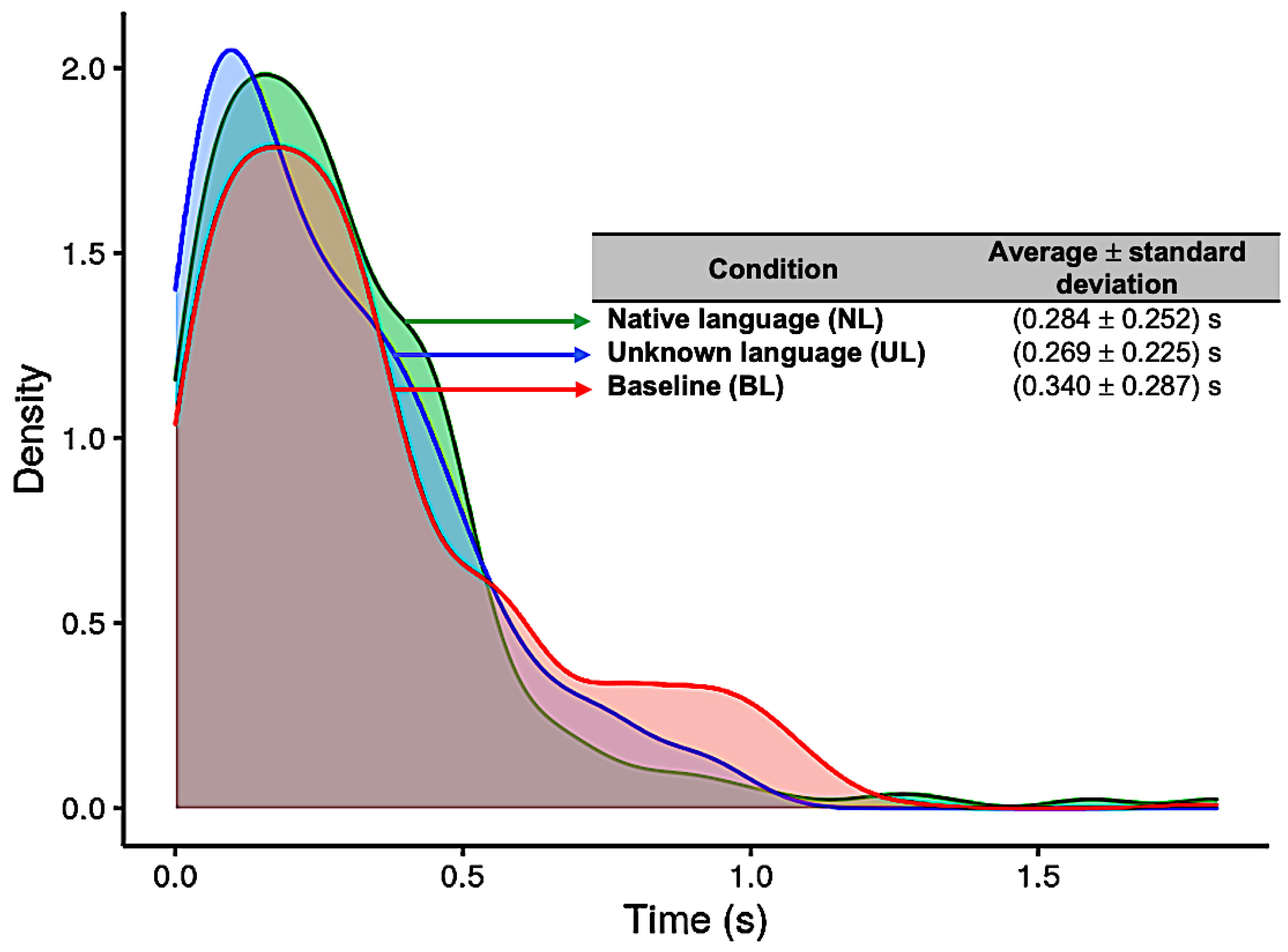
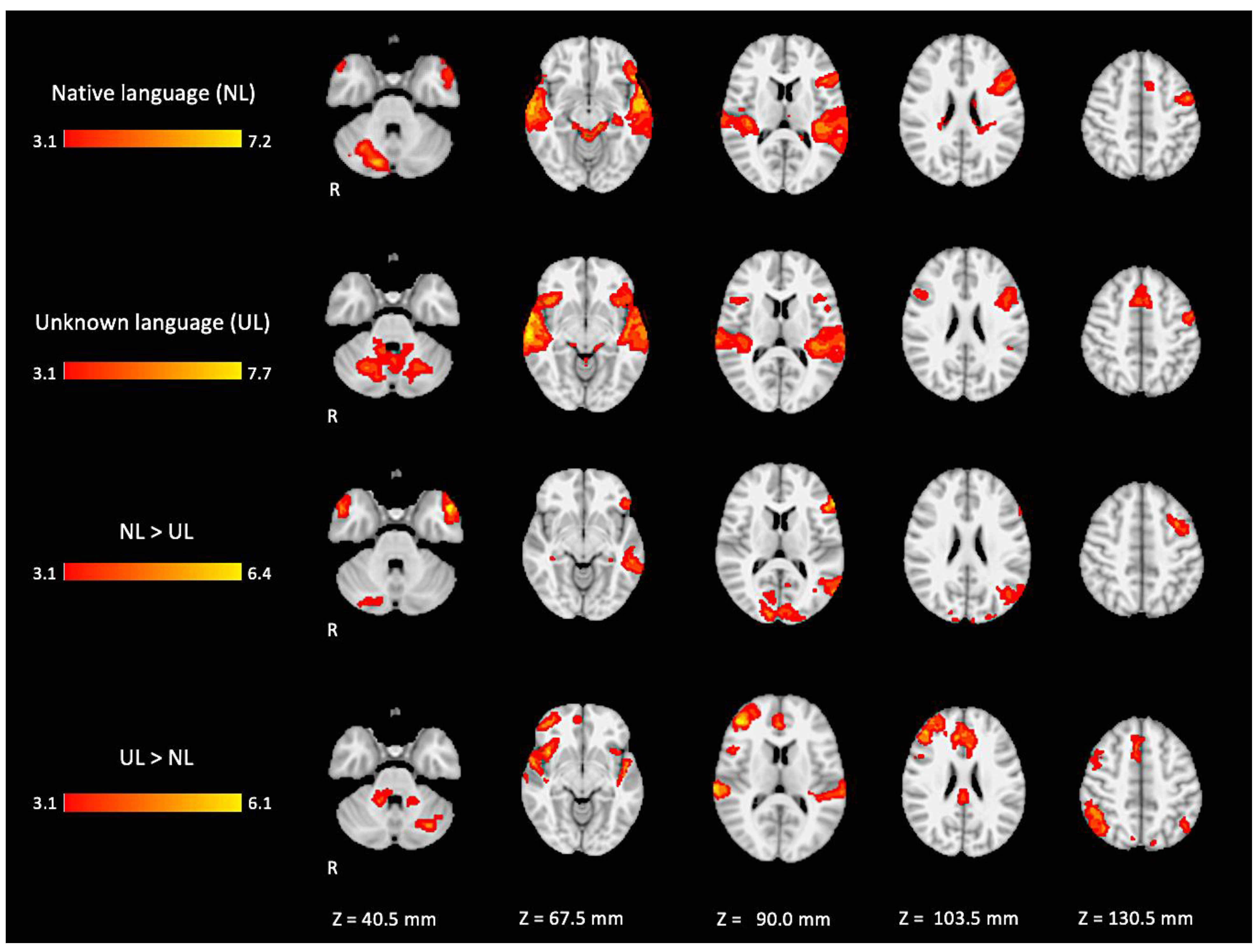
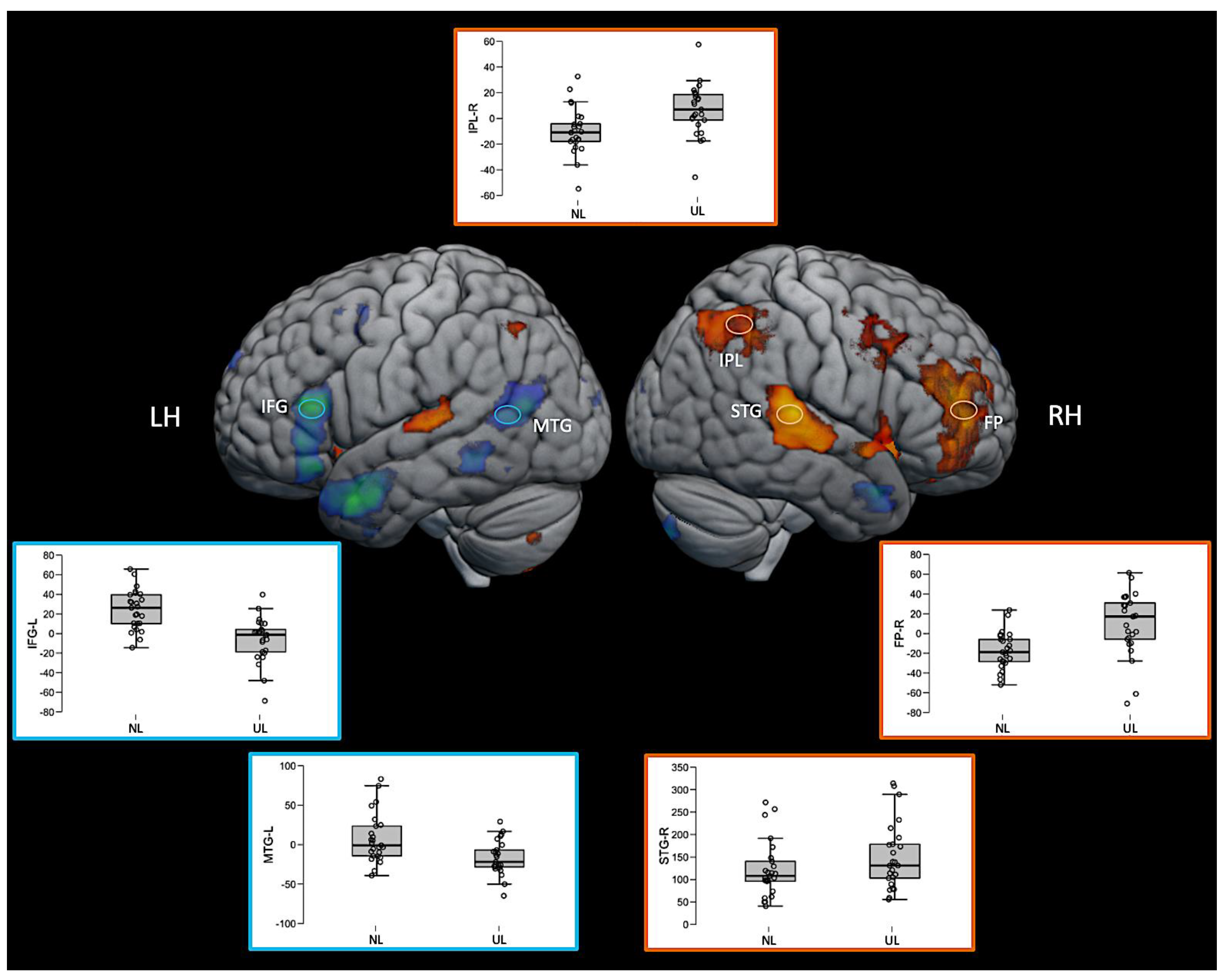
| Condition | HR (Sum) | FA (Sum) | D-Prime |
|---|---|---|---|
| Native Language (NL) | 22.011 | 0.092 | 5.263 |
| Unknown Language (UL) | 16.905 | 0.874 | 3.154 |
| Baseline (BL) | 22.885 | 0.046 | 5.985 |
| Z Score | MNI Coordinates (mm) | Brain Regions | |||
|---|---|---|---|---|---|
| x | y | z | |||
| NL | 7.14 | −58 | −16 | 0 | Left superior temporal gyrus |
| 7.24 | 62 | −14 | −8 | Right middle temporal gyrus | |
| 6.18 | 16 | −78 | −30 | Posterior lobe of right cerebellum | |
| 5.6 | −4 | 4 | 58 | Left supplementary motor cortex | |
| 5.25 | 0 | −40 | −14 | Anterior lobe of cerebellum | |
| UL | 7.26 | −58 | −16 | 0 | Left superior temporal gyrus |
| 7.7 | 66 | −20 | −4 | Right superior temporal gyrus | |
| 6.04 | 30 | −72 | −60 | Right cerebellum | |
| 5.96 | 4 | 10 | 56 | Right Superior frontal gyrus/premotor cortex | |
| 4.55 | −30 | −72 | −58 | Left cerebellum | |
| NL > UL | 6.47 | −58 | 28 | 14 | Left inferior frontal gyrus, pars triangularis |
| 4.93 | 14 | −92 | 14 | Right occipital lobe/cuneus | |
| 4.72 | −56 | −70 | 14 | Left middle temporal gyrus | |
| 5.01 | 26 | −82 | −46 | Posterior lobe of right cerebellum | |
| 4.87 | −36 | 8 | 48 | Left middle frontal gyrus | |
| 5.33 | 54 | 0 | −26 | Right middle temporal gyrus, anterior division | |
| 4.36 | −6 | 62 | 34 | Left superior frontal gyrus | |
| 4.14 | −6 | −58 | 6 | Left precuneus cortex | |
| 3.98 | 34 | −36 | −2 | Right hippocampus | |
| UL > NL | 6.1 | 44 | 44 | 14 | Right middle frontal gyrus |
| 5.57 | 2 | 42 | 20 | Right Paracingulate Gyrus | |
| 4.94 | 50 | −42 | 44 | Right supramarginal gyrus, posterior division | |
| 5.01 | −48 | −12 | −6 | Left superior temporal gyrus | |
| 5.08 | −32 | −68 | −34 | Posterior lobe of left cerebellum | |
| 5.18 | 4 | −32 | 30 | Right cingulate gyrus, posterior division | |
| 4.32 | 16 | −46 | −32 | Anterior lobe of right cerebellum | |
| 4.3 | −12 | −74 | 28 | Left cuneus/precuneus cortex | |
| 3.7 | −8 | −54 | −26 | Anterior lobe of left cerebellum | |
| 4.62 | −28 | −70 | −60 | Left cerebellum | |
| 4.11 | −46 | −60 | 48 | Left angular gyrus/inferior parietal lobule | |
| 4.43 | 12 | −68 | 40 | Right precuneus cortex | |
Publisher’s Note: MDPI stays neutral with regard to jurisdictional claims in published maps and institutional affiliations. |
© 2021 by the authors. Licensee MDPI, Basel, Switzerland. This article is an open access article distributed under the terms and conditions of the Creative Commons Attribution (CC BY) license (https://creativecommons.org/licenses/by/4.0/).
Share and Cite
Cotosck, K.R.; Meltzer, J.A.; Nucci, M.P.; Lukasova, K.; Mansur, L.L.; Amaro, E. Engagement of Language and Domain General Networks during Word Monitoring in a Native and Unknown Language. Brain Sci. 2021, 11, 1063. https://doi.org/10.3390/brainsci11081063
Cotosck KR, Meltzer JA, Nucci MP, Lukasova K, Mansur LL, Amaro E. Engagement of Language and Domain General Networks during Word Monitoring in a Native and Unknown Language. Brain Sciences. 2021; 11(8):1063. https://doi.org/10.3390/brainsci11081063
Chicago/Turabian StyleCotosck, Kelly R., Jed A. Meltzer, Mariana P. Nucci, Katerina Lukasova, Letícia L. Mansur, and Edson Amaro. 2021. "Engagement of Language and Domain General Networks during Word Monitoring in a Native and Unknown Language" Brain Sciences 11, no. 8: 1063. https://doi.org/10.3390/brainsci11081063








